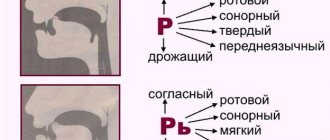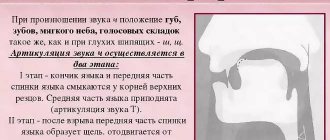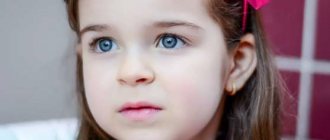Dysarthria is a name for speech disorders caused by damage to the central nervous system.
The disorder is characterized by a decrease in the mobility of the speech apparatus, as a result articulation suffers. Dysarthria in children can cause incorrect pronunciation of words, writing and reading disorders, as well as general underdevelopment of speech, or its complete absence. Among various speech therapy pathologies, dysarthria ranks second in prevalence, only dyslalia is more common. Therefore, today much attention of specialists and parents is paid to this speech disorder.
Reasons for development
Dysarthria is not an independent disease, although often this speech disorder is the main manifestation of various pathologies of the central nervous system. In most cases (up to 85%), dysarthria accompanies cerebral palsy. Malformations of the nervous system can be caused by a variety of reasons:
- pathological conditions of the fetus during intrauterine development. These include severe toxicosis and the pathological course of pregnancy, chronic maternal diseases and intrauterine infections, hypoxia, asphyxia or ischemia of the fetal brain, Rh conflict, etc.;
- genetic predisposition (presence of severe hereditary pathologies);
- head injuries and illnesses suffered by a child in the first few years of life. These include hydrocephalus, meningitis and other neuroinfections, purulent otitis media, as well as poisoning with toxic substances and intoxication due to infectious diseases.
The above reasons lead to damage to the parts of the brain that control movement, the cerebellum, basal ganglia, brain stem, nerve fibers and their connections with muscles.
Manifestations of dysarthria are different, and they depend on which part of the central nervous system is affected.
Why does it happen?
Innervation of the speech motor nerves usually occurs due to more serious “failures” in the functioning of the central nervous system. In 70-80% of cases, this speech disorder accompanies a pathology such as cerebral palsy. Cerebral palsy and impairment of the ability to clearly pronounce speech sounds have common causes, common origins and prerequisites. The functioning of the central nervous system is disrupted in utero, either during childbirth, or in the first hours or days after birth. Brain lesions are usually organic, associated with birth injuries and fetal hypoxia.
Experts see a close connection between the nature of the mother’s pregnancy and the possible development of dysarthria in the child. Thus, in women who suffered from severe toxicosis while expecting a baby, in those who were found to have fetal hypoxia, or Rh conflict between mother and child, the likelihood of speech disorders in the child is higher. Organic brain damage can be caused by acute hypoxia during childbirth, the development of severe kernicterus after birth, and the birth of a child prematurely - in premature infants, depending on the period at which they appeared, central nervous system lesions are a common phenomenon.
All of the above does not mean that pathology cannot develop in boys and girls who were born healthy and not burdened with diagnoses such as cerebral palsy. And at the age of 2 years, and at 4 years, and at 5 years, and at any other age, innervation of the speech apparatus can occur in children as a complication after suffering severe encephalitis, meningitis, purulent. Pathology often develops with hydrocephalus, after a child receives a head injury, and also as a consequence of brain damage after severe poisoning.
Main features
If a child has a speech disorder such as dysarthria, then his articulatory muscles will be in a state of hypotonia. This makes speech unclear and also causes other problems caused by bulbar disorders.
Among the most common symptoms of dysarthria are the following:
- The lips are in an open state, the tongue spontaneously falls out.
- Lips closed too tightly. This manifestation is caused by spasm of the muscles of the articulatory apparatus.
- Flaccid or inactive tongue (with dystonia of articulatory muscles).
- Problems with swallowing and chewing food, excessive salivation and inability to swallow food, as well as other bulbar disorders.
- Speech development at an early age does not correspond to the norm (the baby does not babble, the first words appear after 2 years, etc.).
- The child does not suffer from ENT diseases, but still speaks through his nose. Nasal tint occurs due to low mobility of the palate. The air stream does not encounter any obstacles on its path and freely enters the nasal passages.
- Improper speech breathing, difficulty pronouncing long phrases, frequent pauses in speech, etc.
- The speech lacks melody, it is too drawn out or, conversely, fast.
- Distortion, substitution or omission of sounds.
- Too high, squeaky voice.
- Impaired fine motor skills. Dysarthria in children is manifested by the inability to fasten buttons, reluctance to assemble small construction sets, etc.
In severe forms of dysarthria due to paralysis of the speech muscles, complete muteness may be observed. This condition is called anarthria.
All manifestations of dysarthria are usually very persistent and difficult to correct.
Dysarthria: symptoms
Dysarthria at various levels of its manifestation is characterized by a violation of the transmission of impulses from the cerebral cortex to the nuclei of the cranial nerves. Given this feature, the corresponding nerve impulses do not arrive to the muscles (these are the articulatory, vocal and respiratory muscles), as a result of which the function of the main type of those cranial nerves that are directly related to speech (vagus, hypoglossal, facial, trigeminal) is subject to disruption and glossopharyngeal).
Due to the trigeminal nerve, innervation of the lower part of the face and masticatory muscles is ensured; damage to this nerve determines the urgency of difficulties associated with opening/closing the mouth, as well as with movements carried out by the lower jaws, with swallowing and chewing.
The hypoglossal nerve provides muscle innervation concentrated in the area of the two anterior thirds of the tongue. Accordingly, when the facial nerve is damaged, certain disturbances in the mobility of the tongue arise, in addition to which difficulties arise in holding it in a certain given position.
The innervation of the facial muscles is provided, accordingly, by the facial nerve. Damage to this nerve results in a mask-like and facial expression, as well as difficulty closing the eyes, puffing out the cheeks, or furrowing the eyebrows.
Innervation of the posterior third of the tongue is provided by the glossopharyngeal nerve; in addition, it innervates the soft palate and pharyngeal muscles. If this nerve is damaged, the voice takes on a nasal tone, the pharyngeal reflex decreases, and the small tongue deviates to the side.
As for the vagus nerve, it innervates the muscles of the pharynx, soft palate, larynx, respiratory muscles and vocal folds. When the vagus nerve is damaged, the muscles of the pharynx and larynx begin to work ineffectively, and breathing functions are also affected.
During the early period of manifestation of dysarthria with these disorders in infants, the following symptoms are noted: muscle pareticity leads to difficulty in breastfeeding (attachment to the breast is carried out by 3-7 days, that is, late), choking, frequent regurgitation and sluggish sucking are characteristic.
The early stage of development of children may be accompanied in this case by the absence of babbling; the same sounds that appear sound nasal. Children pronounce their first words with a delay (mostly at 2-2.5 years), the subsequent development of their speech is accompanied by incorrect pronunciation of almost all types of sounds.
Dysarthria can also be accompanied by articular apraxia, which means a disturbance in the process of voluntary movements of the articulatory organs. The cause of articulatory apraxia may be a lack of kinesthetic sensations in the articular muscles of children.
Disturbances associated with sound pronunciation and arising against the background of articular apraxia have two main features, they are as follows:
- Sounds that are in close proximity to each other in the area of their articulation are subject to change and distortion;
- the resulting disturbances in sound pronunciation are characterized by their own inconstancy; accordingly, this determines the cases in which a child can pronounce certain sounds both in the correct version and in the incorrect version.
Articulatory apraxia can manifest itself in two ways:
- articular kinesthetic apraxia – is directly related to pathology in the parietal regions of the brain, which, in turn, is accompanied by difficulties in finding a separate variant of articulatory posture;
- articular kinetic apraxia - is caused by the occurrence of pathology in the area of the premotor parts of the brain, this manifests itself in the form of a violation of the dynamic organization in articulatory movements, which makes it difficult to move from one sound to another.
In addition, the symptoms of dysarthria are accompanied by various repetitions of syllables and sounds, their insertions, permutations and omissions. Physically, children are clumsy; they often stumble and fall; difficulties associated with performing physical exercises are relevant (this is particularly noticeable when compared with other children). Due to impaired fine motor skills, children have problems with lacing, fastening buttons, etc.
Types of dysarthria
There are several ways to classify this speech disorder. Clinical forms of dysarthria are distinguished based on which areas and parts of the central nervous system were affected:
- bulbar occurs when the medulla oblongata is damaged. The name comes from the Latin word bulbus, which translates as onion. This is the shape of the medulla oblongata. This section of the central nervous system is responsible for the functioning of the cranial nerves that ensure the functioning of the tongue and pharynx. There are practically no voiced sounds in speech; pronunciation takes on a nasal tone. With the bulbar form of dysarthria, not only speech disorders are observed. Paralysis of the muscles of the larynx and pharynx leads to difficulties in swallowing food, especially solid and liquid, it is very difficult for the child to chew, emotions are not displayed on the face;
- subcortical is caused by damage to the subcortical nodes of the brain. The main manifestation of pathology in this case is a violation of muscle tone, as well as involuntary contractions of facial and articulatory muscles. As a rule, such movements are especially noticeable when the child is talking, but they can also be observed at rest. Because muscle tone is constantly changing, a child's speech may be completely normal at times. However, at the moment of articulatory spasm, he is not able to utter even a few sounds. Due to such a sharp switching of articulatory movements, speech intelligibility suffers, the timbre and strength of the voice are disrupted. In some cases, subcortical dysarthria is accompanied by hearing loss, which further complicates speech pathology;
- cerebellar in its pure form is rare in children. Various pathologies of the cerebellum lead to speech becoming scanned. During a conversation, the child continually shouts out individual sounds;
- cortical is a form of the disease that is difficult to isolate and recognize. The manifestations of coccal dysarthria are very similar to motor alalia. In both cases, voluntary motor skills of the articulatory apparatus and the pronunciation of words with a complex sound-syllable structure are disrupted. However, with cortical dysarthria there are no violations of the lexico-grammatical aspect of speech. The child experiences difficulty switching from one articulatory position to another. Therefore, he pronounces individual sounds clearly, but in speech there is no automation of them;
- pseudobulbar is a form of dysarthria often found in children. It is this type of disorder that occurs due to damage to the central nervous system during the development of the fetus in the womb, at the time of birth or in the first years of the child’s life. Paralysis occurs as a result of damage to the pathways that carry nerve impulses from the cerebral cortex to the nuclei of the hypoglossal, vagus and glossopharyngeal nerves. The clinical manifestations of the pathology are similar to bulbar dysarthria, however, the pseudobulbar form is easier to correct.
Pseudobulbar dysarthria
This form, in turn, is conventionally divided into three degrees, based on the severity of the pathology. A mild degree of pathology is not associated with gross violations of the motor skills of the articulatory apparatus. Such a child has slow tongue movements and they are not precise enough. There are no problems with chewing and swallowing, sometimes choking is possible.
Speech is often slow, sounds are blurred, especially those that are complex in articulation (zh, sh, r, ts, ch). When pronouncing voiced sounds, there is insufficient participation of the voice; difficulties also arise when pronouncing soft sounds, since the rise of the middle part of the tongue towards the hard palate is added to the main articulatory posture.
Sound disorders often lead to the child experiencing difficulties in analyzing sounds, phonemic development suffers, and errors may occur when writing. At the same time, there is practically no violation of grammatical structure, vocabulary and word structure. That is, with a mild form of pseudobulbar dysarthria, the child experiences phonetic-phonemic underdevelopment (FFN) of speech; other signs of pathology can be detected only with a thorough examination.
If the child’s mental development and hearing are not affected, then regular classes with a speech therapist at a clinic or educational institution will help correct the situation.
Mild forms of pseudobulbar dysarthria, as well as severe ones, are rare. The largest group consists of children with moderate pathology. First of all, they are distinguished by their amicability: due to paralysis of the facial muscles, the child cannot puff out his cheeks, close or stretch his lips.
Limited tongue movements are also noticeable: the child is unable to hold it in one position, turn it to the sides or lift it. It is very difficult to transition from sound to sound when changing articulatory postures; due to the sedentary palate, the voice takes on a nasal tint. Speech is very slurred, since the lips are inactive and often closed, others have difficulty understanding the child.
This degree of pseudobulbar dysarthria greatly complicates the child’s learning process at school, so such children are often recommended classes in specialized institutions where an individual approach to students with this speech disorder is practiced.
The severe form of pseudobulbar dysarthria is called anarthria. This is complete inactivity of the speech apparatus against the background of deep muscle damage. A child with this form of disorder has a constantly open mouth, the lower jaw droops, and the face looks like a mask. Speech may contain individual sounds, but more often it is completely absent.
Extreme dysarthria is a severe speech disorder that is difficult to correct. However, in the absence of mental disabilities, the child can be educated in specialized schools. Classes with a speech therapist, based on special techniques, will allow such a child to successfully master writing skills and gain knowledge in basic school subjects.
As mentioned above, the division into degrees of severity is quite arbitrary; no one has established clear boundaries between these conditions. What all these forms of speech disorder have in common is that the distortion of sounds does not affect the rhythmic contour of the word. That is, the child pronounces words with different numbers of syllables and observes stress. But when there is a combination of consonants, the child may “lose” one sound, for example, a squirrel will turn into a bek, etc.
In addition, difficulties in transitioning from one sound to another leads to the replacement of consonants. Instead of the word “scissors” the child will say no-si-sy. The tongue remains in one articulatory position, characteristic for the pronunciation of the sound “S”, and does not move for the correct pronunciation of the sounds “Zh” and “C”.
Dysarthric children often have problems with sound analysis. They are unlikely to pass the generally accepted tests that determine the level of this skill. A third-grader with this speech disorder will find, for example, four sounds in the word “cat”: K, A, T, A. When selecting pictures depicting words starting with the sound “B”, this child will also select words starting with the sound “P” etc.
Article:
Dysarthria is one of the most common severe speech disorders. Otherwise, it is also called “tongue-tied” or “porridge in the mouth.” Speech is inarticulate, often “squelching”, the pronunciation of sounds is interdental, there are no sibilants, vibrants and affricates. The pronunciation of the sounds of early ontogenesis is distorted: M, P, B, D, T, K, G, X. Violation of the pronunciation side of speech in children is due to insufficient innervation of the speech muscles. Working with such children takes more time and requires a lot of work from a speech therapist and the patience of parents. Etiology A distinctive feature of dysarthria is a violation of the prosodic and pronunciation aspects of speech. Articulation, intonation, rhythm, voice production, and tempo suffer due to organic damage to the central and peripheral nervous system. Causes of dysarthria in children and adults The causes of nerve damage are various unfavorable factors either during the intrauterine development of the child, or during childbirth or after birth due to diseases. Speech problems arise as a result of damage to those areas of the brain that are necessary to control the motor mechanisms of speech. When the peripheral parts of the nervous system are damaged, the structures of the motor nerves to the muscles of the jaw, lips, tongue, cheeks, palate, pharynx, larynx, diaphragm and chest are disrupted, as well as the structure of the nuclei that are located in the trunk and in the subcortical regions of the brain, which are responsible for the unconditional reflexive emotional speech reactions, such as laughter, crying. When parts of the central nervous system are damaged, the subcortical-cerebellar nuclei and pathways that regulate muscle tone, the order of muscle contractions of the speech muscles and the coordination in the work of the articulatory, vocal and respiratory apparatus are insufficiently developed. As a result, the prosodic component of speech is disrupted: volume, smoothness, tempo, timbre, emotional expressiveness. If the conduction systems that direct impulses from the cerebral cortex to the underlying structures of the motor apparatus are damaged, muscle tone in the muscles of the speech apparatus increases and reflexes of oral automatism increase. With central damage, the cortical parts of the brain that ensure the formation of speech abilities are also underdeveloped. The causes of dysarthria are different in adults and children. In adults, it is caused by impaired cerebral circulation due to vascular diseases, traumatic brain injuries, brain tumors, and infectious diseases (meningitis, encephalitis). Children have intrauterine pathology of the fetus: hypoxia, rubella, maternal illness, use of certain medications; birth injuries, incorrect position of the fetus during childbirth, asphyxia, large fetus, Rh factor conflict. Groups of children with dysarthria are heterogeneous. There is no direct relationship between the severity of the defect and the severity of the deviations. Symptoms in children Dysarthria can be either a primary defect or secondary due to alalia, rhinolalia, aphasia, stuttering, cerebral palsy, mental retardation, hydrocephalus, mental retardation, hearing and vision impairment. Dysarthria is most common in children with minimal brain dysfunction. Along with insufficiently clear pronunciation and impaired prosody, symptoms such as mild impairments of memory, attention, emotional-volitional sphere, and intellect are observed; finger motor skills suffer; they grasp small objects with a brush. The formation of a number of mental functions may be slowed down: some movements are reduced or may be absent. For example, a child begins to stand earlier than sit, does not know how to grab a ball, go down stairs, or jump. Often these children had no or weak crawling stage, due to which the brain is actively divided into the right and left hemispheres, forming speech zones. Emotional and volitional disorders in dysarthrics appear in the 1st year of life. The set of symptoms is as follows: such children are restless, cry a lot, require increased attention, their sleep is disturbed, their appetite is either lacking a sense of proportion (fullness) or they eat poorly. There is a predisposition to regurgitation, vomiting, diathesis, gastrointestinal disorders, they refuse to suckle at the breast, leakage of milk is observed during sucking from under one or both corners of the mouth, they do not adapt well to weather changes, and are weather dependent. In preschool and school age, the symptoms are as follows: children are restless motorly, excessively fussy, prone to irritability, mood swings or apathy, and show rudeness and disobedience in relationships with adults or peers. When tired, motor restlessness intensifies. They are prone to a hysterical type reaction, especially if they achieve what they want. Articulatory motor skills in all forms of dysarthria are impaired to varying degrees, and profuse salivation (salivation) is observed. Forms of dysarthria Modern classification of the disease is based on the principle of localization of the disorder. There are bulbar, cerebellar, cortical, subcortical or extrapyramidal, pseudobulbar and erased forms of dysarthria. Bulbar dysarthria Bulbar dysarthria - (from the Latin bulbus - a bulb, which in shape resembles the medulla oblongata) is the result of a disease or inflammation of the medulla oblongata, as a result of which unilateral or bilateral damage to the facial nerve occurs. The cause may be a viral disease or otitis media. With unilateral damage, flaccid paralysis of the muscles of the lips and one cheek develop, which leads to unclear articulation of labial sounds. With bilateral damage, the pronunciation of all labial sounds follows the pattern of their approximation to a single voiceless fricative labial-labial or bilabial sound (instead of V-F). All stop consonants are reduced to a fricative anterior lingual unvoiced sound (instead of B-P). The sounds are not differentiated; dysphonia (voice disorder) or aphonia (lack of sonority in the voice) is characteristic. Impaired pronunciation in bulbar dysarthria is often accompanied by nasalization, nasal sound (can-decoy), lack of facial expressions, hypersalivation, disorder of sucking and swallowing solid food. Cerebellar dysarthria Cerebellar dysarthria is caused by damage to the cerebellum, in which its connections with other parts of the central nervous system are disrupted. Speech in this form of dysarthria is slow, impulsive, chanting, with disturbances in stress, volume, and fading of the voice towards the end of the phrase (reminiscent of the speech of a drunk person). There is a decreased tone of the muscles of the tongue and lips. The tongue is thin, spread out, its mobility is limited, the pace is unhurried, the soft palate sags, chewing is weakened, and facial expressions are sluggish. The child cannot maintain an articulatory posture, and excessive or insufficient range of tongue movements appears. When straining and performing these movements, a tremor of the tongue is observed. The patient's medical history always includes PPCNSL. Prosody and expressiveness of speech are disturbed, breathing is impaired. Most sounds are nasalized, the pronunciation of anterior lingual and labial sounds is impaired. A child with a cerebellar form of dysarthria usually speaks later than others. Features of general motor skills - movement disorder, the child often falls, many injuries. Most children have disproportionately large heads. Due to low muscle tone, the child has poor posture (possibly remnants of cerebral palsy), folds in half, and lies on the table. In most cerebellar dysarthrics, intelligence is preserved. Cortical dysarthria Cortical dysarthria manifests itself as a motor speech disorder of various pathogenesis. There are several variants of cortical dysarthria: 1. Dysarthria caused by unilateral, but more often bilateral, lesions of the lower part of the anterior central gyrus. Selective central damage to the muscles of the articulatory apparatus most often affects the tongue, which leads to a decrease in the volume of fine, targeted movements. Usually the tip of the tongue is affected, so the pronunciation of the anterior lingual sounds (Ш, Ж, Р, Л) is impaired; in severe forms, these sounds are absent in speech, in the lungs they are replaced by soft or hard whistling or anterior lingual sounds (instead of T – Ть, instead of Д-Дь) . Difficulty arises in setting L-L, and the tempo and fluency of speech may be disrupted. 2. Dysarthria is associated with bilateral damage to the cortex of the dominant hemisphere in the lower postcentral parts of the cerebral cortex. It is difficult to pronounce sibilants and affricates. Articulation disorders are variable and ambiguous. In some cases the child speaks, but in others he cannot speak, because it takes a long time to find the right way of life, so the pace and fluency of speech slows down. There is insufficient sensitivity of the face. The child finds it difficult to pinpoint the touch. 3. Dysarthria is caused by unilateral damage to the cortex of the dominant hemisphere in the lower parts of the premotor areas. There is a lack of dynamic praxis, an inability to switch from one articulatory posture to another. The production of affricates is difficult (they break down into their component parts). Replacing fricative sounds with stop sounds (Z to D, S to T). Omissions of sounds when consonants coincide, selective deafening of voiced stop consonants. Speech is slow and unnatural. Subcortical or extrapyramidal Subcortical or extrapyramidal dysarthria. The main feature is the appearance of forced movements in the muscles of not only the speech apparatus, but throughout the entire body. Violation of sound pronunciation is determined by a change in muscle tone in the facial muscles during speech, hyperkinesis, a disorder of the impulses of the speech muscles and the emotional-motor sphere. A child suffering from subcortical (extrapyramidal) dysarthria experiences difficulty maintaining articulatory posture, which is associated with constantly changing muscle tone. In a relaxed state, muscle tone is reduced; in a state of fatigue, emotional stress, a sharp increase in muscle tone occurs, and violent movements appear (for example, moving the fingers during speech). The tongue sharply tenses, groups into a lump, pulling itself towards the root. The tension is transmitted to the vocal apparatus and respiratory muscles. In cases of severe disturbances, speech is blurred, slurred, with a nasal tint, with the voice fading towards the end of the phrase, turning into unclear muttering. This form of dysarthria is combined with hearing impairment of the type sensorineural hearing loss. Pseudobulbar dysarthria Pseudobulbar dysarthria occurs in 96% of cases. It is caused by bilateral damage to the motor corticonuclear pathways running from the cerebral cortex to the nuclei of the cranial nerves of the trunk. With pseudobulbar dysarthria, high muscle tone is noted in the articulatory muscles, similar to a spasm in the muscles, as a result of which active movements of the articulatory apparatus are limited, in severe forms - their complete absence. At the same time, reflexive automatic movements are preserved: swallowing, breathing, etc. When pronouncing the sounds P, B, D, the tongue is tense and pulled back, the back is rounded, closing the passage to the pharynx, the tip of the tongue is not pronounced, the volume of voluntary movements is small. A child suffering from pseudobulbar dysarthria can stick his tongue out of his mouth, but the amplitude of these movements is limited, it is difficult to hold a wide tongue in the midline, it deviates to the side, drops behind the lower lip or curls towards the chin. When performing the “Clock” exercise, the tongue oscillates in a small amplitude and slowly “furrows” along the lip. The child cannot raise the tongue to the upper lip when performing the “Tasty Jam” exercise or reaches the nose with the tip of the tongue, helping with the lower lip. Complex, voluntary articulatory movements are impaired, while involuntary reflex movements are preserved. Pronouncing voiced sounds is difficult, but they can be heard in coughing, crying, laughing, and sneezing. Whistling sounds may be preserved, disturbances begin with hissing Ш, Ж, Ш, Ш. The sound Р can be single-impact, but is more often replaced by fricatives Т or Д. The sound Л is distorted. Violation of sound pronunciation in pseudobulbar dazarthria is in the distortion variant. Hidden form Hidden form of dysarthria (SFD) is one of the variants of pseudobulbar dysarthria, which is revealed during a thorough examination. With minor dysarthric disorders, inactivity of the muscles of the speech apparatus (soft palate, lips, tongue) is observed due to damage to some parts of the central nervous system. Signs of SFD are: Salivation when the tongue is tense. Deviation is the deviation of the tongue from the midline in the “Scapula” position. Asymmetry of the tongue. Tremor of the tongue. There may be disturbances in gross motor skills. The child does not fit into the tempo during music lessons, performs basic movements poorly, and poor coordination is noticeable. For example, he cannot stand on one leg for a long time. Poorly developed fine motor skills of the fingers. The child slowly masters self-care skills, holds a fork and spoon in his fist, changes clothes poorly, and does not know how to cut. Spatial orientation is impaired: left-right, cannot find the center on a sheet of paper. In articulatory motor skills, disturbances are noticeable both during static and dynamic exercises. The muscular strength of fixation of articulatory postures of the tongue suffers, the child quickly gets tired. Coordination of movements, their volume and amplitude are impaired. Sound pronunciation is impaired, as in dyslalia, but when sounds are automated, work is slowed down. The prosodic side of speech suffers: the pace is slow, when the child tries to speak faster, swallows endings and syllables. His breathing is arrhythmic, he tries to speak while inhaling. Speech is slurred, diction is impaired.
Treatment of dysarthria
Since dysarthria can be a manifestation of a variety of nervous system disorders, there is no single treatment regimen for this pathology. The child, first of all, should be examined by a neurologist. He also carries out the treatment. Classes with a speech therapist are auxiliary in this case; they are part of a complex of treatment measures, which also includes:
- drug treatment. After making a clinical diagnosis, the neuropathologist determines the order of treatment measures, prescribes medications, etc. All this is carried out taking into account the severity of the underlying neurological disease, as well as the age of the child. It should be remembered that there is no pill for dysarthria . The medications used in therapy eliminate the main symptoms of the pathology and alleviate the condition of the small patient, making him more susceptible to other methods of correction;
- massage. Manual procedures can reduce the severity of muscle paralysis;
- breathing exercises. Dysarthric children often experience difficulties with speech breathing. Special exercises help them learn to control the exhaled flow, which allows them to normalize the tempo and rhythm of speech;
- physiotherapy.
If you notice symptoms of dysarthria in your child, you should contact a specialist as soon as possible. The sooner doctors and speech therapists begin to deal with dysarthric, the higher the chance of normalizing speech and avoiding difficulties with learning at school.
Even a mild form of dysarthria requires correction, primarily due to the fact that the child himself feels constrained. He is aware of the mistakes in his speech and is offended when others do not understand him. All this leads to the fact that a dysarthric child withdraws into himself and completely stops communicating with the people around him.
Work to normalize speech should be carried out not just by a speech therapist, but by a speech pathologist with sufficient qualifications and experience. When correcting dysarthria, special speech therapy techniques are used, without knowledge of which it is impossible to help a dysarthric child. And, of course, a speech pathologist must have great patience and endurance, because correction of dysarthria is usually difficult and takes a lot of time. The child may not make contact, refuse to complete the proposed tasks, or perform them incorrectly.
Despite all the efforts of specialists, in some cases the correction does not bring the desired results. The reason for this may be problems in the family. For a child to speak, he must be surrounded with love and care. Parental support is of great importance.
Other types of classifications
The French neurologist Tardieu proposed classifying dysarthria according to how well others can understand the dysarthric person’s speech. As a result, he identified four degrees of severity of the violation:
- Only a specialist can identify violations.
- Speech problems are noticeable to others, but speech is understandable.
- Only people from his immediate environment can understand a child.
- There is no speech at all or it is incomprehensible even to the child’s loved ones.
This classification is very clear and convenient. It is often used in their work not only by speech therapists, but also by educators, psychologists, and teachers.
In speech therapy work, the division of dysarthria into types is also often used based on the syndromic approach. In this case, the speech therapist should work together with a neurologist. The doctor determines the leading symptom, and the teacher identifies similar defects in the functioning of the speech apparatus.
Using this approach made it possible to identify the following types of dysarthria:
- spastic-paretic – with the leading syndrome being spastic paralysis;
- spastic-rigid – spastic paralysis and rigidity syndromes;
- hyperkinetic – hyperkinesis;
- ataxic – ataxia;
- spastic-atactic – spastic paralysis and ataxia;
- spastic-hyperkinetic – spastic paralysis and hyperkinesis;
- spastic-atacticohyperkinetic – spastic paralysis, ataxia, hyperkinesis;
- ataxic-hyperkinetic – ataxia and hyperkinesis.
Dysarthria is also divided into types based on the severity of the disorder. In mild forms, speech disorders are minor, often noticeable only when tired. This form is also called erased.
Mild dysarthria has much in common with dyslalia. The only difference is that dysarthric sufferers experience neurological microsymptoms.
The average degree is direct dysarthria (severe), characterized by obvious speech impairments, it becomes slurred, blurred, but generally remains understandable to others.
In severe dysarthria, a person’s speech cannot be understood. If the pronunciation side of speech is impossible, then this form is called anarthria.
Prevention
Quite often, parents of children suffering from dysarthria blame themselves. But this speech disorder in many cases develops for reasons beyond a person’s control. No doctor can predict the development of dysarthria in the prenatal period, but a pregnant woman’s compliance with these rules will reduce the risk of developing all kinds of central nervous system pathologies:
- Timely consultation with a doctor and registration. In modern medicine, it is customary to monitor a woman throughout the entire period of pregnancy. With the help of various studies, doctors assess the condition of the fetus, reduce the risks of developing various pathologies, etc. But many women neglect this, turn to specialists late or do not register at all. The development of pathology is difficult to predict, but it can be noticed in time and appropriate measures taken. The sooner this is done, the higher the chance of having a healthy baby.
- Proper nutrition and giving up bad habits. No matter how trivial it may sound, this aspect is very important for the health of not only the expectant mother, but also her baby. In order for the fetus to form correctly, it is necessary to provide the body with a sufficient amount of useful microelements. Taking medications, alcohol-containing drinks and smoking can make unwanted adjustments to the process of formation of vital organs and the central nervous system. It is especially important to monitor your diet during the first trimester of pregnancy.
- Refuse to visit public places for a while, especially during periods of increased incidence of influenza and other infectious diseases.
Avoid stress, spend more time outdoors, try to get as many positive emotions as possible!
To prevent the development of dysarthria in early childhood, it is necessary to provide the child with proper care. Head injuries and all kinds of diseases, especially infectious ones, undermine the baby’s health and negatively affect his development.
Be attentive to yourself and your child, your health is in your hands!






